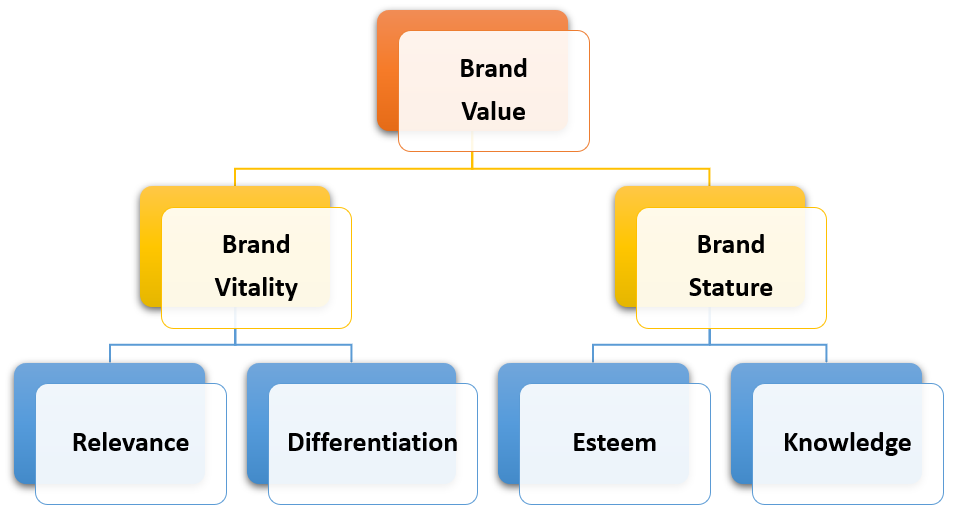Brand Asset Valuator (BAV) is a metric applied for the measurement of brand value of an entity. Brand Asset Valuator was developed by an agency called “Young and Rubicam”. BAV measures a brand under the 2 broad heads of:
The brand asset valuator model is the result of a research program conducted by advertising agency Young & Rubicam. The agency interviewed over 100,000 consumers in 32 countries to gauge their perception of more than 13,000 brands.
The key finding of the program was that brand value emerges only once sufficient time has passed. Put differently, brand perception develops progressively in the mind of the consumer.
This progression is explained via four pillars: differentiation, relevance, esteem, and knowledge. In the next section, we’ll take a look at each pillar in more detail.
- Brand Vitality which refers to the current and future growth potential that a brand holds in it.
- Brand Stature which refers to the power of a brand.

Both of these heads can be further divided to have the following parameters for judging the brand-
- Differentiation: It is the ability of a brand to stand apart from its competitors. Differentiation has three constituents to it. These are
Different: Refers to how do the brand’s offering differs from its rivals.
Unique: Refers to the brand’s quality and carries the essence of its existence. It has more to do with the credibility, authenticity and originality of the idea that the brand carries.
Distinctive-refers to the worthiness of a brand.
- Relevance: This refers to how closely can the consumers relate to the brand’s offering and is a significant driver for a brand’s penetration.
- Esteem: This refers to the consumer perception about the brand. Whether a brand is popular or not, whether it delivers on its stated promises- all this contribute in building up the esteem of the brand.
- Knowledge: This refers to the degree of awareness about a brand in the minds of its consumers. This is very important in building a brand and making the consumers understand of what the brand actually stands for and its implicit message to the consumers.
The Brand asset valuator power grid
The BAV power grid can be used to capture the relationship between each of the four pillars. Power grids show the relative strengths and weaknesses of a brand, which clarifies strategic direction. They also help clarify the role of each element in a marketing mix.
On the vertical axis of the grid, the current strength of a brand in terms of relevance and differentiation is plotted. On the horizontal axis, esteem and knowledge are plotted. Both axes are measured from low to high, with a new brand starting its journey from the bottom left-hand corner and progressing through each pillar.
The grid is then divided into four quadrants, called pillar patterns:
New/unfocused: Describing a new brand that has recently entered the market, but occasionally an old, stagnant, unfocused, or unknown brand. Both must seek to build awareness and traction by establishing uniqueness, meaning, and personality.
Niche/unrealized: This pillar pattern includes successfully emerging or momentum brands leading with differentiation. They experience healthy and consistent growth which eventually builds relevance, esteem, and knowledge.
Leadership: At this point, brand leadership has been achieved with the organization enjoying increased revenue. Brand leaders display high levels of all four pillars. However, the BAV model acknowledges that most leading brands will decline if they fail to innovate and maintain a competitive advantage.
Eroded: These brands have high knowledge but low esteem, relevance, and differentiation. That is, consumers are aware of the brand but choose to shop elsewhere. In theory, the brand then becomes old and stagnant which returns it to the first pillar pattern.
One thought on “Young and Rubicam’s Brand Asset Valuator”